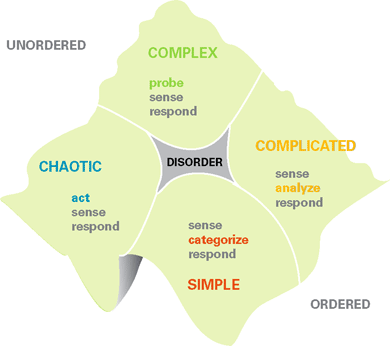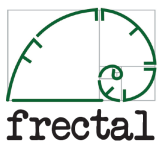Chaos-Complex-Complicated-Simple and Cynefin
We have looked at the healthcare field and will be exploring further management and information technology areas in later articles. We are doing so for the simple reason that my current work spans these domains and I am keen to share some related thoughts.
After a formal education in medical school, I was armed with the related medical vocabulary. Yet that language is very different to that used by the management and software engineering folk I now work with.
Understanding the differences and commonality in languages and mental frameworks between disciplines is in many ways key to tackling multidisciplinary challenges (e.g. Healthcare reform) today. In the modern world differing folk with differing backgrounds increasingly need to come together to tackle challenges together.
Over time I have found myself looking across these disciplines for some common patterns that span across disciplines and found some common ground that I think may be useful to share.
One of the key aspects of that common ground is that all 3 disciplines can learn from complex systems science which is a multidisciplinary field that crosses most/all other scientific fields and is very helpful. We will shortly look in a little more detail at this critically important field.
While “complex systems/complex adaptive systems” science is very useful, if you have explored it in the past you may have found it challenging to reconcile with your educational background and structured training.
Thankfully there is a framework that I find a simple yet effective way to reconcile many of the challenges in the modern world named Cynefin. While it has emerged from the leading work of Dave Snowden from the knowledge management industry I believe it has very widespread applicability. Within this field there are a number of related and valuable schools of thought including work by Ralph Stacey (Agreement & Certainty Matrix) and adaptations by Brenda Zimmerman et al (Edgeware).
Very briefly the Cynefin framework explains the world across 4 key states, from simple to complicated to complex to chaos. (There is a 5th state, namely disorder, which must also be mentioned).
Simple
You began your education with the basics of reading, writing and arithmetic. While challenging at the time, you likely take these challenges for granted now and might class them as “simple” to do.
Complicated
Further along your education you most likely will have chosen a path that you enjoyed/preferred for a variety of reasons. While your chosen field may have appeared a “complicated” at the outset, requiring years of study and effort, over time you will have got a very good grasp of the subject. Indeed you may be a master in that field. Those from a scientific background will be familiar with this domain.
Complex
Regardless, there is for all of us, stuff that appears more than complicated, complex even, that stretches our ability and it can be hard to explain how, but some how we get through these challenges. Within the complexity, patterns emerge and can be distinguished and harnessed, which may be understood as the art within many disciplines.
Chaos
At the edge of complex challenges, occasionally lies chaos… a bad day, an organisational mess, a challenge so unwieldy that chaos is the only word that fits..

In brief, the Cynefin principles of how to deal with each of these domains can be summarised as follows..
Simple: Sense, Respond, Categorise (Best practice)
Complicated: Sense, Analyse, Respond (Good practice)
Complex: Probe, Sense, Respond (Emergent Practice)
Chaos: Act, Sense, Respond (Novel Practice)
We will now try to look for some common ground between three disciplines, Emergency Medicine, Management and Information Technology, using the Cynefin framework which should help to explain and illustrate its value
We will then conclude this section with a look for a single pattern that emerges from exploring these three fields.
- It’s become a complex world; an-introduction-to-Complexity
- Cynefin and Healthcare
- Cynefin and Management
- Cynefin-and-Information-Technology
- Amidst the complexity simple patterns emerge
We then explore common patterns amidst the complexity of change.
References;
Cognitive Edge: Dave Snowden Articles on Cynefin:
http://www.cognitive-edge.com/articlesbydavesnowden.php
Cynefin http://en.wikipedia.org/wiki/Cynefin
Snowden D, Kurtz (2003) “The new dynamics of strategy: Sense-making in a complex and complicated world” IBM Systems Journal Vol 42 No 3, 2003
Ralph Stacey’s Agreement & Certainty Matrix;
http://www.change-management-toolbook.com/mod/book/view.php?id=74&chapterid=58
Zimmerman, B , Lindberg C and Plsek (1998) EdgeWare: insights from complexity science
http://www.plexusinstitute.org/edgeware/archive/think/main_aides3.html





Are clinical systems often not just complex, but adaptive as well. Surely the 7 degrees of separation, algorithms and topology are useful in understanding this.
Russ
By: russell canavan on December 3, 2014
at 10:52 am
Thanks Russ,
You’re correct and I was using the shorthand “complex systems” to refer to “complex adaptive systems” and their science.
You might like to explain what you mean by 7 degrees of separation/algorithms/topology in this context?
thanks, Tony
By: Tony Shannon on December 3, 2014
at 11:05 am
Mobile keyboard, sorry. It should have read six degrees of separation in “big data” complex adaptive systems. There is the world of statistics which can be problematic sometimes. Take the simple example of patient to baysean “diagnosis” probability leading to a bunch of studies with a further probability of various outcomes. That’s without taking behaviour into account!!!! Surely this is a problem for computer learning and decision support. Algorithms.
The topology stuff was a reference to topological interpretation of the symmetrical and asymmetrical datasets.
It’s good to see a fellow medic and information person into this stuff as it seems fundamental. I have been reading / open sourcing and building systems for decades and haven’t met many people interested in this area
Russ
By: russell canavan on December 3, 2014
at 1:33 pm